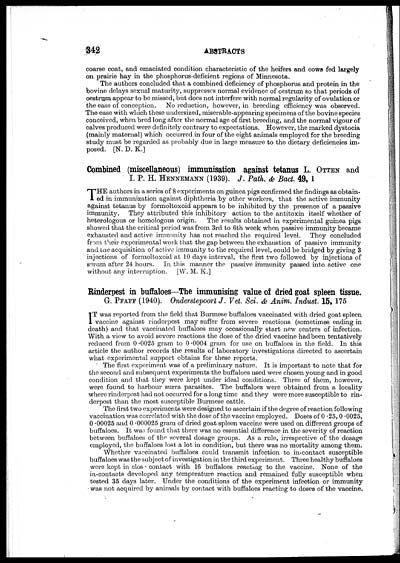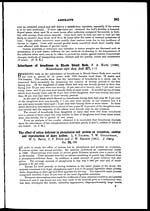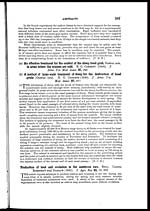Medicine - Veterinary > Veterinary colleges and laboratories > Indian journal of veterinary science and animal husbandry > Volume 12, 1942 > Original articles > Abstracts
(378) Page 342
Download files
Individual page:
Thumbnail gallery: Grid view | List view

342 ABSTRACTS
coarse coat, and emaciated condition characteristic of the heifers and cows fed largely
on prairie hay in the phosphorus-deficient regions of Minnesota.
The authors concluded that a combined deficiency of phosphorus and protein in the
bovine delays sexual maturity, suppresses normal evidence of oestrum so that periods of
oestrum appear to be missed, but does not interfere with normal regularity of ovulation or
the ease of conception. No reduction, however, in breeding efficiency was observed.
The ease with which these undersized, miserable-appearing specimens of the bovine species
conceived, when bred long after the normal age of first breeding, and the normal vigour of
calves produced were definitely contrary to expectations. However, the marked dystocia
(mainly maternal) which occurred in four of the eight animals employed for the breeding
study must be regarded as probably due in large measure to the dietary deficiencies im-
posed. [N. D. K.]
Combined (miscellaneous) immunisation against tetanus L. OTTEN and
I. P. H. HENNEMANN (1939). J. Path. & Bact. 49, 1
THE authors in a series of 8 experiments on guinea pigs confirmed the findings as obtain-
ed in immunization against diphtheria by other workers, that the active immunity
against tetanus by formoltoxoid appears to be inhibited by the presence of a passive
immunity. They attributed this inhibitory action to the antitoxin itself whether of
heterologous or homologous origin. The results obtained in experimental guinea pigs
showed that the critical period was from 3rd to 6th week when passive immunity became
exhausted and active immunity has not reached the required level. They concluded
from their experimental work that the gap between the exhaustion of passive immunity
and the acquisition of active immunity to the required level, could be bridged by giving 3
injections of formoltoxoid at 10 days interval, the first two followed by injections of
serum after 24 hours. In this manner the passive immunity passed into active one
without any interruption. [W. M. K.]
Rinderpest in buffaloes—The immunising value of dried goat spleen tissue.
G. PFAFF (1940). Onderstepoort J. Vet. Sci. & Anim. Indust. 15, 175
IT was reported from the field that Burmese buffaloes vaccinated with dried goat spleen
vaccine against rinderpest may suffer from severe reactions (sometimes ending in
death) and that vaccinated buffaloes may occasionally start new centres of infection.
With a view to avoid severe reactions the dose of the dried vaccine had been tentatively
reduced from 0.0025 gram to 0.0004 gram for use on buffaloes in the field. In this
article the author records the results of laboratory investigations directed to ascertain
what experimental support obtains for these reports.
The first experiment was of a preliminary nature. It is important to note that for
the second and subsequent experiments the buffaloes used were chosen young and in good
condition and that they were kept under ideal conditions. Three of them, however,
were found to harbour surra parasites. The buffaloes were obtained from a locality
where rinderpest had not occurred for a long time and they were more susceptible to rin-
derpest than the most susceptible Burmese cattle.
The first two experiments were designed to ascertain if the degree of reaction following
vaccination was correlated with the dose of the vaccine employed. Doses of 0.25, 0.0025,
0.00025 and 0.000025 gram of dried goat spleen vaccine were used on different groups of
buffaloes. It was found that there was no essential difference in the severity of reaction
between buffaloes of the several dosage groups. As a rule, irrespective of the dosage
employed, the buffaloes lost a lot in condition, but there was no mortality among them.
Whether vaccinated buffaloes could transmit infection to in-contact susceptible
buffaloes was the subject of investigation in the third experiment. Three healthy buffaloes
were kept in close contact with 16 buffaloes reacting to the vaccine. None of the
in-contacts developed any temperature reaction and remained fully susceptible when
tested 35 days later. Under the conditions of the experiment infection or immunity
was not acquired by animals by contact with buffaloes reacting to doses of the vaccine.
Set display mode to: Large image | Zoom image | Transcription
Images and transcriptions on this page, including medium image downloads, may be used under the Creative Commons Attribution 4.0 International Licence unless otherwise stated. ![]()
| India Papers > Medicine - Veterinary > Veterinary colleges and laboratories > Indian journal of veterinary science and animal husbandry > Volume 12, 1942 > Original articles > Abstracts > (378) Page 342 |
|---|
| Permanent URL | https://digital.nls.uk/75328242 |
|---|
| Description | Covers articles from 1942. |
|---|




